Science with the Murchison Widefield Array
Author(s)
Cappallo, Roger J.; Corey, Brian E.; Coster, Anthea J.; Erickson, Philip J.; Goeke, Robert F.; Hewitt, Jacqueline N.; Kincaid, Barton B.; Kratzenberg, Eric W.; Lonsdale, Colin John; Matthews, Lynn D.; McWhirter, Stephen R.; Morgan, Edward H.; Remillard, Ronald Alan; Rogers, Alan E. E.; Salah, Joseph E.; Whitney, Alan R.; Williams, Christopher Leigh; ... Show more Show less
DownloadHewitt_Science with.pdf (3.008Mb)
OPEN_ACCESS_POLICY
Open Access Policy
Creative Commons Attribution-Noncommercial-Share Alike
Terms of use
Metadata
Show full item recordAbstract
Significant new opportunities for astrophysics and cosmology have been identified at low radio frequencies. The Murchison Widefield Array is the first telescope in the southern hemisphere designed specifically to explore the low-frequency astronomical sky between 80 and 300 MHz with arcminute angular resolution and high survey efficiency. The telescope will enable new advances along four key science themes, including searching for redshifted 21-cm emission from the EoR in the early Universe; Galactic and extragalactic all-sky southern hemisphere surveys; time-domain astrophysics; and solar, heliospheric, and ionospheric science and space weather. The Murchison Widefield Array is located in Western Australia at the site of the planned Square Kilometre Array (SKA) low-band telescope and is the only low-frequency SKA precursor facility. In this paper, we review the performance properties of the Murchison Widefield Array and describe its primary scientific objectives.
Date issued
2013-04Department
Haystack Observatory; MIT Kavli Institute for Astrophysics and Space ResearchJournal
Publications of the Astronomical Society of Australia
Publisher
CSIRO Publishing
Citation
Bowman, Judd D., Iver Cairns, David L. Kaplan, Tara Murphy, Divya Oberoi, Lister Staveley-Smith, Wayne Arcus, et al. “Science with the Murchison Widefield Array.” Publications of the Astronomical Society of Australia 30 (January 2013).
Version: Original manuscript
ISSN
1323-3580
1448-6083